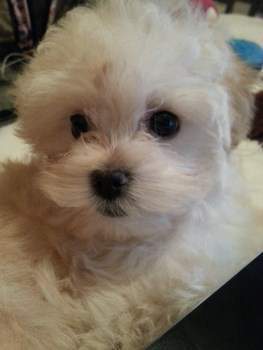Maltipoo Eyes
Overview
This section is dedicated to all of the aspects regarding Maltipoo eyes and hopefully will answer the many questions that owners have in regard to color, care, health issues and cleaning elements.
Here, we will discuss:
- Color
- Care
- Infections
- Discharge (including what is commonly called 'eye boogers')
- Allergies
- Problems (including red, bloodshot eyes)
- Cleaning
Please note:
PetMaltipoo is reader-supported. Some of the product suggestions on this page are affiliate links. As an Amazon Associate we earn from qualifying purchases. This is at no extra cost to you and helps us continue creating useful content.

Maltipoo Eye Color
2nd generation refers to pups born from a Maltipoo to Maltipoo mating as opposed to 1st generation in which a toy Poodle is paired with a Maltese.
1st generation dogs will hold traits from both Poodle and Maltese breed, however 2nd (and 3rd, 4th and so on) generation Maltipoo are pulling more traits from his/her Maltipoo parents. Genetics go at least 5 generations back, therefore a 2nd generation Maltipoo will have one generation of Maltipoo traits and four possible traits brought in by 4 generations back (grandparents, great-grandparents, and so on).
With this said, it is true that traits held by the dam and sire will have the most affect in regard to eye coloring (and this holds true for coat color
as well).
Most, but not all, Poodles have dark eyes. The standard calls out for 'dark eyes'. The actual color will vary from amber to dark amber… almond to black. The Maltese standard calls out for 'very dark' eyes. While black eyes are preferred, many Maltese have lighter eyes ranging from amber to dark chocolate brown. Very few have blue eyes, as it simply is not a trait of this breed.
There are some Poodles with blue eyes, though this is rare since it is related to the merle color which is being bred out of the breed as it has been linked to health problems. Note that Merle itself does not cause health issues; however, it is when merle to merle is bred that issues often arise. And since a dog can have 'hidden' merle genes, breeding merles is not recommended.
Looking the aforementioned colors that are possible, we can know that most Maltipoos will have dark eyes, ranging from amber to black, once that change takes place and eyes darken on a newborn puppy.
The few blue eyed Maltipoos that exist most likely have a merle Poodle somewhere in the bloodline - and most often within those 5 generations back that have the most influence on the traits that a puppy will inherit. There are a few exceptions such as a Maltipoo with hazel or very light brown eyes; but this is very rare since both Maltese and Poodles generally have dark eyes.
Note: When a Maltipoo has an eye that holds 2 different colors, this is known as partial heterochromia. If a Maltipoo has 2 completely different colored eyes, this is known as full heterochromia. While this is rare, it is not often related to any particular health issues.
Testing to Rule Out Inherited Eye Issues
The most serious of Maltipoo eye problems can be avoided with good breeding practices. Before purchasing a
Maltipoo puppy, potential owners should insist on seeing documentation that clears the dam and sire (and therefore the puppy) of the most serious genetic eye disorders that affect both Poodles and Maltese.
This type of testing is known as CERF and a reputable breeder will ensure that all dogs in his/her program will be CERF tested. One of the most prevalent issues that can be passed genetically is Progressive Retinal Atrophy (PRA).
PRA is a disease that affects the retina of the eye and sadly, it progresses to blindness. It develops in both eyes at the same time and while it is not painful for a dog, it is certainly a huge issue to contend with. By the time that an owner notices the first signs - dilated pupils and excessive shininess- the eye disease has already taken its grip.
Night blindness or trouble with peripheral vision may occur first. However, with most dogs that have this eye issue, it will progress to total blindness within 1 year of diagnosis. There is no cure. For this reason, it bears repeating that dam and sire should be CERF certified before entering into a breeding program.

Milla, 14 weeks old
Photo courtesy of Anita Rodriguez
Maltipoo Eye Infections
Maltipoo eye infections are not that uncommon. The eyes are vulnerable to all sorts of debris and germs. Most eye infections are due to bacteria that enter from around the eye area. There are less common reasons as well, such as viruses, trauma to the eye, and allergy issues (however in these cases, the infection is a secondary issue).
With budgets tight and owners looking for home remedies to fix Maltipoo eye infections as opposed to paying for a clinical vet visit, there are some home remedies that may seem tempting to try. However, it should be stressed that bringing your Maltipoo to the vet is the best course of action. There may be a small tear that you cannot see and most importantly, many eye infections must be treated with antibacterial eye drops - something that owners just do not have access to in the house.
With this said, let's look at some of the most popular home remedies and see if they work or not:
Saline solution - This can be found over the counter. Flushing an eye with this may clean out debris; however it will not cure a bacterial infection.
Chamomile Tea - Some purport that placing a cooled tea bag (after it has warmed and seeped for several minutes) to a dog's eye will aid in treatment.
Signs of a Maltipoo Eye Infection
• Persistent redness
• Excessive tearing
• Pawing at the eye(s)
• Excessive discharge
• Crusting
• Excessive blinking
• Sensitivity to light
The Most Common Eye Infections are:
- Conjunctivitis (pink eye) - Can be bacterial or viral. Causes include Lyme disease, injury to the tear sac, debris
- Glaucoma – Can lead to blindness if not treated. Signs include cloudiness, enlarged pupils, redness. Professional veterinary treatment is vital.
- Keratoconjunctivitis Siccac (dry eye) - tear ducts are blocked and/or infected. Without treatment can progress into eye ulcers and/or cornea damange. Should be treated with eye drops (artificial tears) and sometimes with other medicatoins such as anti-inflammartory and/or anti-bacterial.
- Juvenile Cellulitis - Happens to dogs under the age
of 2. Most obvious sign are blisters around the eyes. Can then turn into ulcers.
If your Maltipoo shows any signs of infection, a checkup should be scheduled asap, as many eye diseases and infections best respond to treatment when caught early.
Bloodshot Eyes
When this happens, superficial blood vessels will in the surface of the affected eye will enlarge and dilate, causing the eye to appear red.
This is often due to an irritation. The most common irritation is a small piece of debris finding its way into a dog's eyes. If a Maltipoo is outside, a tiny piece of dirt or sand particle may become stuck in the eye… or when inside, even a tiny food particle may be the cause.
With acute cases (happening very randomly and not a continuing problem), flushing the eye with clean water (preferably bottled water or filtered water) and help clear out the irritant. This can be done with a small Dixie cup - and having a helper will certainly make things easier.
Another reason why a Maltipoo may have red eyes is allergies. In most cases, this will be an ongoing issue (seasonally or year round) and for more information on this issue, you may wish to look to: Maltipoo Allergies
Discharge
While some irritation may be overlooked and bloodshot eyes may not seem like a serious issue (and in many cases it is not), if this is seen along with discharge coming from a Maltipoo's eyes, it can be a sign of an eye disorder, infection, or other issue that will need prompt treatment.
- Clear discharge can be signs of allergy or debris.
- Yellow, green, puss-like, thick and/or discharge that crusts along the eyelash are all signs of infection and should be brought to the attention of the veterinarian. While most cases can be easily treated with eye drops and antibacterial solution, excessive discharge can also be a symptom of extremely severe eye issues that can lead to blindness; and for this reason prompt, professional veterinarian attention should be sought.
- Brown discharge may simply be a matter of sand, dirt, dust, or debris coloring the otherwise clear discharge.
Eye Boogers (AKA "Goop", "Sleep", Thick Discharge)
While many owners refer to build up in the corners of a Maltipoo's eyes as eye boogers, this is also referred to as 'eye goop'.
If it is green or has a bad odor, this is a sign of infection, however it is quite common for dogs to have a natural secretion that can collect in the corners of the eyes.
Most owners will notice this in the morning when their Maltipoo wakes up. All throughout the day, our puppies and dogs are blinking. That blinking removes dust, debris, and super fine particles from the eye; the eye stays lubricated.
Overnight, when a dog is not blinking, or on days when there are extra irritants (high pollen days, etc.), blinking may not be enough and the discharge can accumulate.
As long as you do not suspect an eye infection, routine cleaning will take care
of these Maltipoo eye boogers.
How to Keep Your Maltipoo's Eye Area Clean
While the Maltipoo is not a particularly high maintenance dog, there are many grooming elements that should be done on a regular basis to keep a puppy or dog healthy, clean, and hygienic. This includes: bathing, brushing, nail trimming, brushing the teeth, cleaning the ears, and cleaning the eye area.
Keeping the eye area clean (along with some other helpful cleaning hints, coming up) will help to keep eye staining away as well.
On many dogs, but most certainly the Maltipoo, the hair around the eyes can quickly become discolored. This is most obvious on white or lighter coated dogs. It is often mistaken for natural hair color; however, red or brown hair surrounding the eyes that develops over time is not normal.
If you are not sure if the coloring is natural or not, touch the hairs. You may notice that they feel crisp and have a different texture than other bits of hairs. What you are feeling is an accumulation of dirt, staining elements, and even in some cases, fine particles of food that have clung to the hairs.
Here are some things that you can do to keep the eye area clean and free of discolored hair:
1)
Your best course of action is to clean the eye area on a daily basis. Recommended, is to give a Maltipoo a nice wipe of the eye area each morning and again after each meal. It only takes about 10 seconds. Use a quality canine eye wipe like Earthbath All Natural Specialty Eye Wipes
 that will not only clean the area but also work to prevent staining.
that will not only clean the area but also work to prevent staining.
If you opt to use a damp cloth, be sure to then go over the area again with a dry one, so that the tiny hairs around the eyes do not remain wet.
Note:
This is for prevention, and to keep the eye area clean. If there are already stains, you will want to use wipes that contain a remover, like Petpost Tear Stain Remover Wipes .
.
2)
Stay away from plastic, colored water and food bowls. There are just horrible. The dyes can slowly leak into food
and water, which can discolor hairs around the face. In addition, contact allergies from plastic bowls is common, even those that are BPA and PVC free, and this can cause discoloration to the nose, and rash around the face.
It is strongly recommended to only use ceramic or stainless steels bowls.
3)
Do not allow your Maltipoo to drink straight tap water. In many towns across the US, the following elements are legally allowed to be present in tap water: Lead, by-products of chlorine treatment, arsenic, radon, and even rocket fuel (low levels, but nonetheless). In fact, there are over 100 toxins that are currently regulated, meaning allowed in low amounts, and many more that are not. In addition, high mineral content can cause discoloration and tear staining to the fine hairs around the eyes.
It is suggested to place a filter on the kitchen tap, use a filtered water pitcher like the
Aquagear Water Filter Pitcher , or use spring/filtered water by the gallon - in many places these are only 50 cents per gallon.
, or use spring/filtered water by the gallon - in many places these are only 50 cents per gallon.
4)
Hopefully you are bringing your puppy or dog with yearly wellness checks. A yearly eye examine will be part of this, which can catch issues that are causing teary eyes, excess discharge, etc. Note that if issues are suspected, an eye exam should be performed by a board certified veterinary ophthalmologist. Many eye diseases and disorders can be treated if caught early.
5)
Notice your Maltipoo's eyes! While you are brushing your dog's teeth or brushing the coat, take time to inspect the eyes. Look for any signs of a problem: redness, cloudiness, swelling. Take note if your dog seems to have itching or irritation - pawing, rubbing eye area against the carpet or the wall and/or squinting.
6)
Keep long hairs away from the eyes. Dogs that have long hairs around the eyes are more prone to eye infections. If your Maltipoo has a show dog style, forehead hairs can be tied up into a topknot. If your puppy or dog has a shorter coat, keep bangs trimmed.
You may also like:
Summer Care for Maltipoos
- How to keep your little guy or gal comfortable no matter how hot the days are.
Winter Care for Maltipoos
- Care tips to keep a Maltipoo happy and healthy all through this long cold season.


